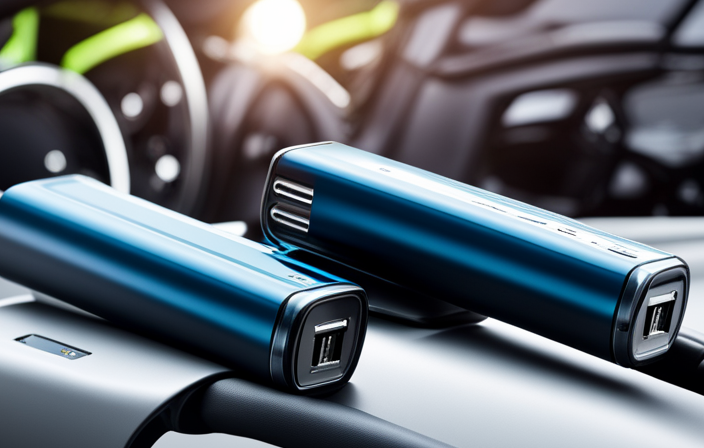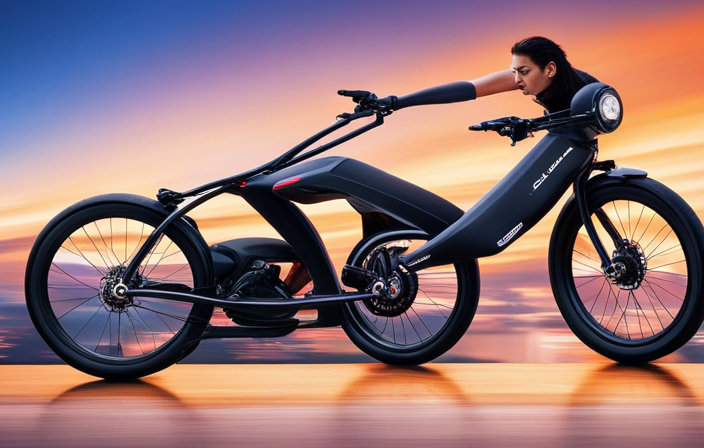Reviving a depleted electric bicycle battery might appear overwhelming, but do not fret! Just like a phoenix emerging from the ashes, your dormant battery can be resurrected.
In this article, I will guide you through the process of assessing the battery’s condition, cleaning the terminals, checking voltage and capacity, and properly recharging it.
We’ll also explore advanced techniques like using a battery desulfator and reconditioning charger.
So, let’s dive in and breathe new life into your electric bike battery!
Key Takeaways
- Storing precautions and maintenance tips are essential to extend the lifespan of an electric bike battery.
- Regularly cleaning battery terminals and connections is important for good conductivity.
- Recharging the battery every few months if storing for long periods can prevent self-discharge and capacity loss.
- Seeking professional battery repair or replacement may be necessary if DIY methods are not effective or if there are underlying issues that require expert diagnosis.
Assess the Battery’s Condition
First, you’ll want to assess the battery’s condition to determine if it can be revived. Check for physical damage by inspecting the battery casing for any cracks, leaks, or signs of corrosion. If you notice any of these issues, it may be difficult to revive the battery.
Additionally, test the battery’s internal resistance using a multimeter. This will give you an indication of its overall health. A high internal resistance indicates a weak battery that may not be salvageable. On the other hand, a low internal resistance suggests that the battery may still have some life left in it.
Once you have assessed the battery’s condition, you can move on to the next step of cleaning the battery terminals and connections. This ensures proper contact and improves the overall performance of the battery.
Clean the Battery Terminals and Connections
Next, make sure to clean the terminals and connections of your e-bike’s power source. Proper battery terminal maintenance is crucial for the efficient functioning of your electric bike. Here are some steps to troubleshoot battery connections:
- Start by disconnecting the battery from the bike.
- Use a clean cloth or brush to remove any dirt, corrosion, or grime from the terminals.
- If you notice any corrosion, mix a solution of baking soda and water, and carefully clean the affected areas.
- Rinse the terminals with clean water and dry them thoroughly before reconnecting.
Maintaining clean and secure connections will help optimize the power flow to your electric bike.
Once you have completed this step, you can move on to checking the voltage and capacity of your battery. This will ensure that your e-bike’s battery is functioning at its best.
Check the Voltage and Capacity
After cleaning the battery terminals and connections, it is important to check the voltage and capacity of the battery to ensure optimal functioning. Testing techniques can help determine the health of the battery and identify any potential issues.
One common method is using a multimeter to measure the voltage. A fully charged electric bike battery should have a voltage reading within the manufacturer’s specified range.
Additionally, it is crucial to check the battery’s capacity, which refers to the amount of energy it can store. This can be done by using a battery capacity tester or by monitoring the battery’s performance during a ride.
Regularly testing the voltage and capacity of the battery is an essential aspect of battery maintenance. By doing so, you can identify any potential problems and take appropriate action.
To recharge the battery properly, follow the next section’s instructions.
Recharge the Battery Properly
To ensure optimal performance, it’s important to recharge your battery properly. Proper charging techniques and avoiding overcharging are crucial for extending the lifespan of your electric bike battery. Here are some key points to remember:
| 1. | Use the charger recommended by the manufacturer. |
| 2. | Make sure the charger is compatible with your battery’s voltage and capacity. |
| 3. | Charge the battery in a well-ventilated area, away from flammable materials. |
| 4. | Avoid charging the battery at extreme temperatures, as it can damage the cells. |
By following these guidelines, you can effectively recharge your electric bike battery and maximize its longevity. However, if you want to further improve the performance of your battery, the next step is to use a battery desulfator. It helps remove sulfate buildup and enhances the battery’s overall efficiency.
Use a Battery Desulfator
Using a battery desulfator can significantly improve the efficiency of your battery. Here are four reasons why it is an essential tool for battery rejuvenation and maintenance:
-
Removes sulfation: The desulfator breaks down the lead sulfate crystals that accumulate on the battery plates, which is the main cause of reduced battery capacity.
-
Enhances charging: By eliminating sulfation, the desulfator allows for better charging, ensuring that the battery reaches its full potential and prolonging its lifespan.
-
Increases capacity: The desulfator helps restore the battery’s capacity by revitalizing the lead sulfate crystals, allowing for more energy storage and longer rides.
-
Saves money: Instead of investing in a new battery, using a desulfator can revive your dead electric bike battery, saving you a significant amount of money.
With the battery now properly maintained and rejuvenated, it’s time to explore the next step: jumpstarting the battery.
Try Jumpstarting the Battery
Jumpstarting the battery can be an effective solution to bring it back to life.
When jumpstarting an electric bike battery, there are a few techniques you can use. First, ensure that the dead battery is disconnected from the bike’s electrical system.
Then, connect the positive (+) terminal of the dead battery to the positive (+) terminal of a fully charged battery using jumper cables.
Next, connect the negative (-) terminal of the charged battery to a suitable ground on the bike.
Finally, attempt to start the bike and let it run for a few minutes. However, it is crucial to follow battery jumpstarting precautions to avoid any potential hazards.
Always wear protective gloves and goggles, and make sure the cables are securely attached before starting the bike. Additionally, be cautious of any sparks or potential electrical risks.
Jumpstarting the battery is just one step towards reviving it; the next section will discuss how to replace faulty cells or components.
Replace Faulty Cells or Components
You can replace faulty cells or components to resolve any issues with the battery.
If you notice that your electric bike battery is not holding a charge or is experiencing a significant drop in performance, it is possible that some of the cells or components are no longer functioning properly.
To fix this, you will need to identify the faulty cells or components and replace them. This may involve opening up the battery pack and carefully removing the damaged parts.
It is important to use caution and follow proper safety procedures when handling and replacing these components.
Once you have replaced the faulty cells or components, you can proceed to the next step of using a battery reconditioning charger to revive your electric bike battery.
Use a Battery Reconditioning Charger
To restore your electric bike battery’s performance, try utilizing a battery reconditioning charger. These chargers use a specialized charging algorithm to break down sulfation, a common issue that reduces battery performance. Battery reconditioning techniques can help revive a dead battery by restoring its capacity and extending its lifespan. They also help balance the battery cells and remove memory effect, allowing the battery to regain its full potential.
However, it’s important to note that not all batteries can be revived using this method, especially if they have severe damage or faulty cells. Additionally, it’s crucial to avoid common battery maintenance mistakes, such as overcharging or leaving the battery discharged for extended periods.
By following proper maintenance practices and storing the battery correctly, you can maximize its longevity and performance.
Maintain and Store the Battery Correctly
Properly maintaining and storing your battery is crucial for maximizing its longevity and performance. To ensure optimal storage and maintenance of your electric bike battery, follow these precautions and tips:
- Store the battery in a cool and dry place, away from direct sunlight and extreme temperatures.
- Keep the battery fully charged before storage to prevent self-discharge and capacity loss.
- Regularly clean the battery terminals and connections to maintain good conductivity.
- Avoid overcharging or deep discharging the battery, as it can lead to irreversible damage.
- If storing for an extended period, recharge the battery every few months to prevent it from fully discharging.
By implementing these storing precautions and maintenance tips, you can significantly extend the lifespan of your electric bike battery.
However, if your battery is beyond repair or is not performing optimally, it may be time to consider professional battery repair or replacement.
Consider Professional Battery Repair or Replacement
After learning about the importance of maintaining and storing the electric bike battery correctly, let’s now delve into the option of considering professional battery repair or replacement.
When it comes to battery maintenance, it’s crucial to remember that not all issues can be resolved through DIY methods. Sometimes, the complexity of the problem requires the expertise of a professional.
Seeking professional repair services ensures that the battery is in the hands of trained technicians who possess the knowledge and tools necessary for accurate diagnosis and effective solutions. They can identify underlying issues that may not be apparent to the untrained eye and perform repairs or recommend a battery replacement if necessary.
Choosing this route can save you time, effort, and potentially extend the overall lifespan of your electric bike battery.
Frequently Asked Questions
Can I use a regular charger to recharge my electric bike battery?
No, using a regular charger may not be suitable for recharging an electric bike battery. Specialized chargers are designed to provide the correct voltage and charging profile, ensuring optimal battery life and performance.
How often should I clean the battery terminals and connections?
Cleaning the battery terminals and connections is crucial to maintain the performance of an electric bike. Signs of dirty terminals include corrosion and poor electrical contact. Regular cleaning ensures optimal power transfer and prevents potential damage to the battery system.
Can I use a battery desulfator on any type of electric bike battery?
Yes, a battery desulfator can be used on any type of electric bike battery. It helps remove sulfation, extending battery life. However, it has limitations. It may not work on severely damaged batteries or if the sulfation is too advanced.
Is it safe to jumpstart an electric bike battery?
Jumpstarting an electric bike battery is not safe due to the risk of damaging the battery or electrical system. It is recommended to use alternative methods like charging the battery with a compatible charger.
How long does it take to recondition a dead electric bike battery using a battery reconditioning charger?
It’s quite amusing how long it takes to recondition a dead electric bike battery using a battery reconditioning charger. The effectiveness of battery reconditioning varies, but it’s worth the wait to revive your bike’s power source.
Conclusion
In conclusion, reviving a dead electric bike battery requires careful assessment, cleaning, and checking voltage and capacity. It also involves proper recharging and the use of a battery desulfator or reconditioning charger. Faulty cells or components may need to be replaced, and the battery should be maintained and stored correctly.
While these steps can often restore a battery’s functionality, it’s important to consider professional repair or replacement if needed. For example, John, a passionate cyclist, was able to revive his electric bike battery by following these steps. This allowed him to continue enjoying long rides without worrying about battery life.









